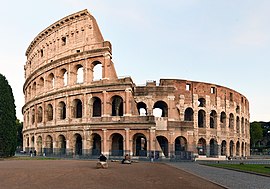 View from the Palatine, near the metro exit | |
 Click on the map for a fullscreen view | |
| Location | Regio III Isis et Serapis, Rome, Italy |
|---|---|
| Coordinates | 41°53′25″N 12°29′32″E / 41.89028°N 12.49222°E |
| Type | Amphitheatre |
| History | |
| Builder | Vespasian, Titus |
| Founded | AD 70–80 |
The Colosseum (/ˌkɒləˈsiːəm/ KOL-ə-SEE-əm; Italian: Colosseo [kolosˈsɛːo]) is an elliptical amphitheatre in the centre of the city of Rome, Italy, just east of the Roman Forum. It is the largest ancient amphitheatre ever built, and is still the largest standing amphitheatre in the world, despite its age. Construction began under the Emperor Vespasian (r. 69–79 AD) in 72[1] and was completed in AD 80 under his successor and heir, Titus (r. 79–81).[2] Further modifications were made during the reign of Domitian (r. 81–96).[3] The three emperors who were patrons of the work are known as the Flavian dynasty, and the amphitheatre was named the Flavian Amphitheatre (Latin: Amphitheatrum Flavium; Italian: Anfiteatro Flavio [aɱfiteˈaːtro ˈflaːvjo]) by later classicists and archaeologists for its association with their family name (Flavius).
The Colosseum is built of travertine limestone, tuff (volcanic rock), and brick-faced concrete. It could hold an estimated 50,000 to 80,000 spectators at various points in its history,[4][5] having an average audience of some 65,000;[6] it was used for gladiatorial contests and public spectacles including animal hunts, executions, re-enactments of famous battles, dramas based on Roman mythology, and briefly mock sea battles. The building ceased to be used for entertainment in the early medieval era. It was later reused for such purposes as housing, workshops, quarters for a religious order, a fortress, a quarry, and a Christian shrine.
Although substantially ruined by earthquakes and stone robbers taking spolia, the Colosseum is still a renowned symbol of Imperial Rome and was listed as one of the New 7 Wonders of the World.[7] It is one of Rome's most popular tourist attractions and has links to the Catholic Church, as each Good Friday the Pope leads a torchlit "Way of the Cross" procession that starts in the area around the Colosseum.[8] The Colosseum is depicted on the Italian version of the 5 euro cent coin.
- ^ Hopkins, p. 2.
- ^ "BBC's History of the Colosseum p. 2". Bbc.co.uk. 22 March 2011. Retrieved 16 April 2012.
- ^ Roth, Leland M. (1993). Understanding Architecture: Its Elements, History and Meaning (First ed.). Boulder, Colorado: Westview Press. ISBN 978-0-06-430158-9.
- ^ William H. Byrnes IV (Spring 2005) "Ancient Roman Munificence: The Development of the Practice and Law of Charity". Rutgers Law Review vol. 57, issue 3, pp. 1043–1110.
- ^ "BBC's History of the Colosseum p. 1". Bbc.co.uk. 22 March 2011. Retrieved 16 April 2012.
- ^ Baldwin, Eleonora (2012). Rome day by day. Hoboken, New Jersey: John Wiley & Sons Incorporated. p. 26. ISBN 978-1-118-16629-1.
- ^ "The New Seven Wonders of the World". Hindustan Times. July 8, 2007. Archived from the original on September 30, 2007. Retrieved July 11, 2007.
- ^ "Frommer's Events – Event Guide: Good Friday Procession in Rome (Palatine Hill, Italy)". Frommer's. Archived from the original on 7 January 2009. Retrieved 8 April 2008.
